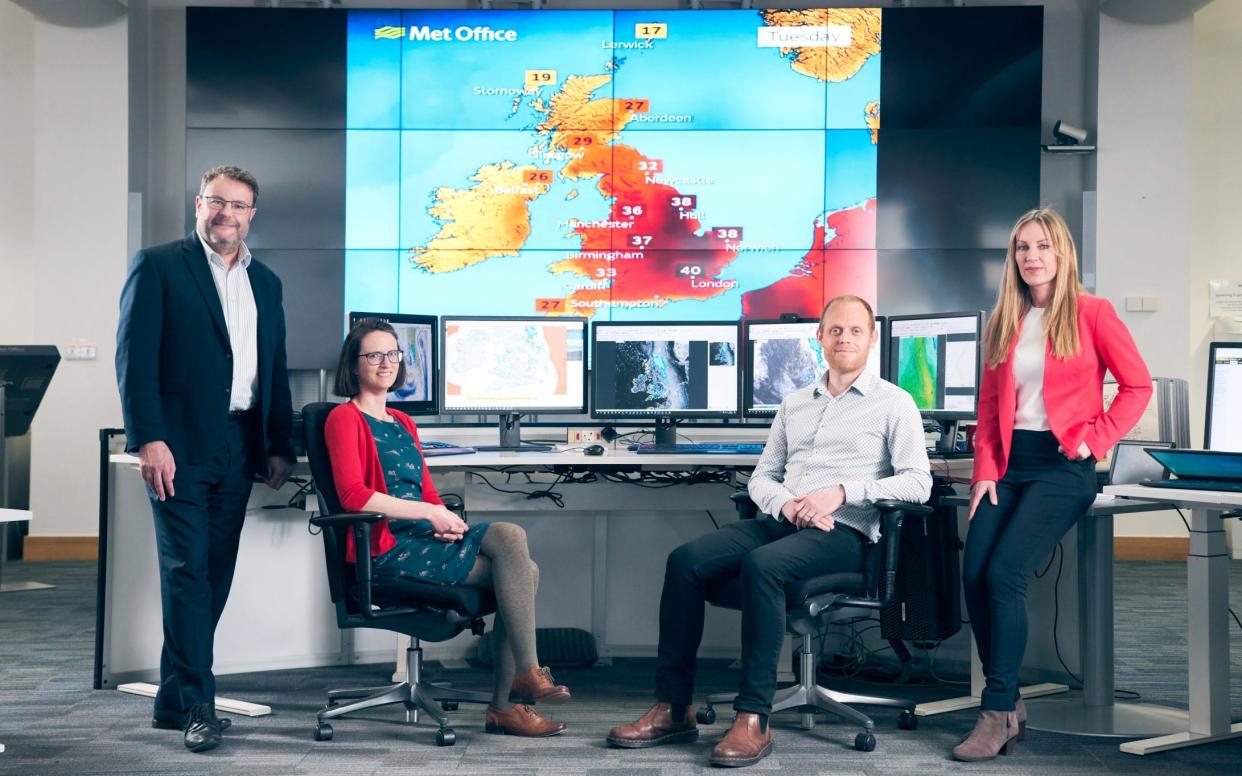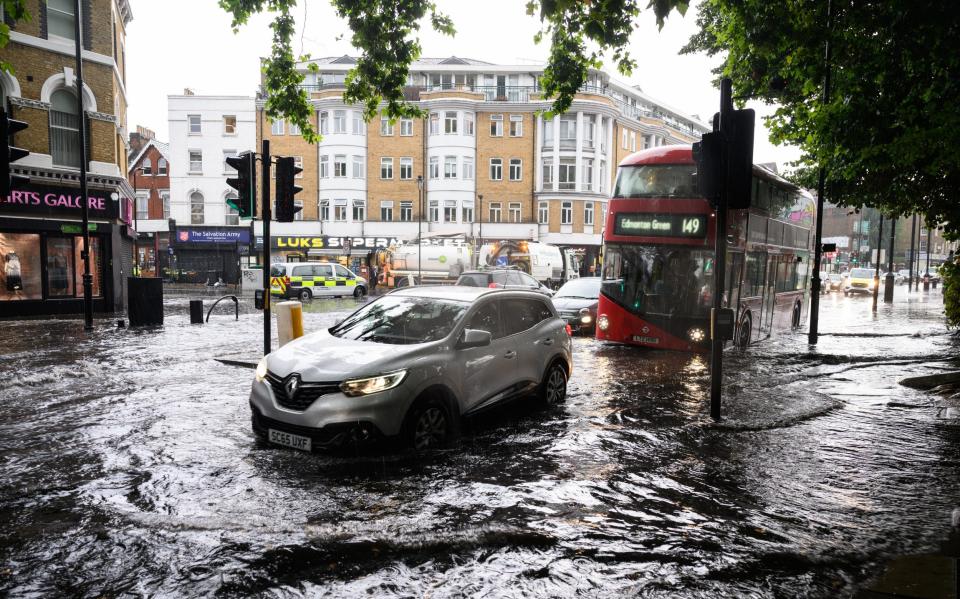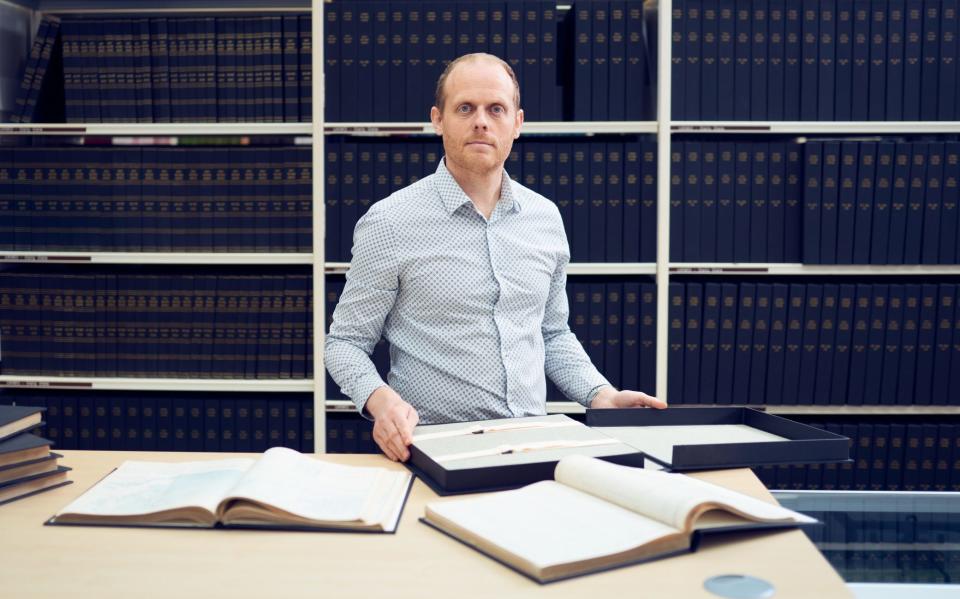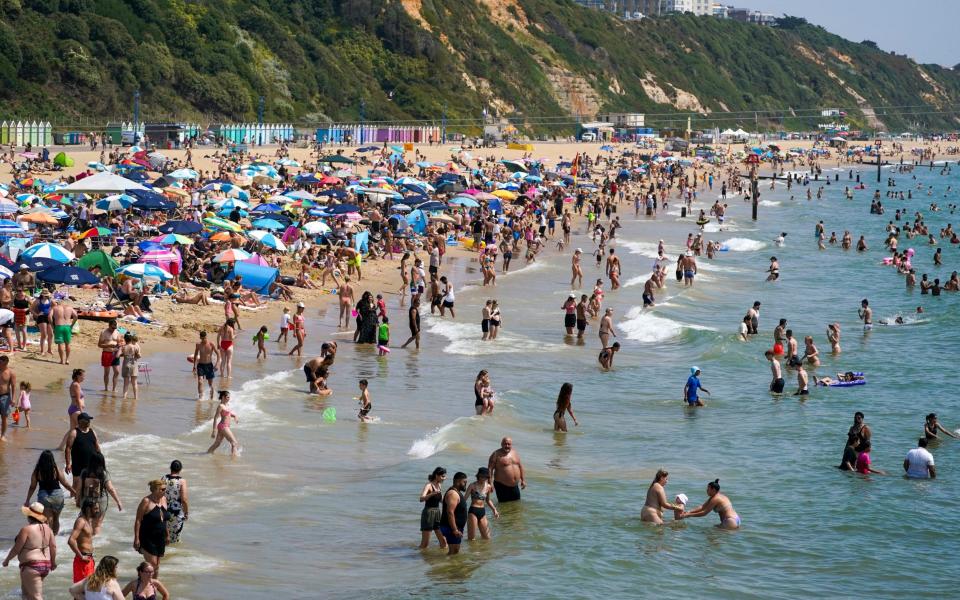The Met Office ‘extreme team’ preparing for the UK’s drastically changing weather

All appears calm inside the operations centre at Met Office headquarters. The room sits at the heart of an £80 million steel-and-glass citadel of science on the edge of Exeter in Devon. Live weather maps and TV feeds are thrown on to a giant video wall. In one corner of the screen, Dermot O’Leary and Alison Hammond are looking at some ‘fresh new frocks for spring’ on This Morning.
Paul Davies, chief meteorologist at the Met Office, stands in the middle of it all. The professor started out as a wet-eared forecaster in Norwich in 1992. The primary tools of his trade were a pencil and rubber. Now, on a grey day in April, he’s talking me through the images produced by multiple data streams from satellites and weather stations. Supercomputers hum in climate-controlled bunkers beneath our feet.
‘Can you see that bold area of cloud moving out to the North Sea, and this speckledness of cloud coming in behind that?’ Davies says. The system he’s describing is bringing cloud and cold air from the north-west, delaying any need for spring dresses. Bar some possible localised lightning later on, there isn’t much to concern the forecasters.
The picture was very different last summer. Davies asks Dan Suri, the duty chief forecaster, to throw on to the big screen a temperature map from 19 July. Now a historical document, it may always have the power to shock, like news footage of a calamity. ‘It was in the models, and we forecast it, but the reality was something different,’ Davies says.

Temperatures soared through the third weekend of July 2022, hitting 38C by Monday 18th as hot air from the south became trapped under a high-pressure ‘heat dome’. Just before midday on the 19th, the Met Office announced a provisional temperature of 39.1C in Charlwood, Surrey, breaking the previous UK record set in Cambridge in July 2019. Soon 46 weather stations recorded temperatures above the 2019 record.
Seven stations hit 40C, including in London and Coningsby in Lincolnshire, where the heatwave peaked at 40.3C. Davies and his team watched in awe as the map on the screen turned an ever-angrier red. Soon it ran out of shades. An almost-black blob spread like oil across a sweltering swathe of England, to almost as far north as Sheffield.
Rolling TV news showed the effects of heat in the corner of the HQ screen that summer. Runways and railways melted and buckled. Schools closed their gates and care homes steamed. The UK Health Security Agency would later record almost 3,000 excess deaths among people aged 65 and over in England during the 2022 heatwaves. Wildfires raged and residents blamed a combusting compost heap for the loss of a whole row of houses in east London.

Temperature records are normally broken by fractions of degrees. On 19 July, a 150-year-old weather station in Durham recorded a temperature of 36.9C – four degrees above its previous high. ‘And then when we saw those [house] fires, I thought, is this just one of many burning right now?’ Davies says. ‘That was a shock, that was different. It hit home to see what 40C actually means in a country like ours.’
In the days after last July’s heatwave, Davies began to consider how the Met Office could better marshal its resources in response to a new age of extremes. The executive agency, which runs as a business owned by the Department for Science, Innovation and Technology, has annual revenues of more than £250 million and employs more than 2,000 people. ‘First we were shocked, then it became a question of, what do we do now?’ he says.

It’s not just heat. Not long after my visit, in early May, torrential rain caused flash floods in southern England. The operations room was similarly agog in July 2021 when a month’s worth of rain fell on parts of London in just an hour or two, twice in two weeks, flooding Tube stations, hospitals and homes. Records show Britain is getting wetter, and deluges exceeding 50mm of rain have become more frequent.
Heat is an even greater concern, a silent killer that affects widespread areas and disproportionately endangers vulnerable people. Records tumbled across the UK last July, when the average maximum temperature exceeded 30C for the first time, rising to 31.5C. Fourteen of the 30 average hottest days across the UK have occurred in the past 20 years.
Global heating boosts evaporation. A warmer, more moist atmosphere increases the capacity for deluges of rain. Disruptions in the jet stream caused in part, according to one theory, by the slowing effects of record high temperatures in the Arctic, also make it more likely for heat domes to form and to stick around for longer.

Davies set about convening a crack squad of scientists from the Met Office’s higher ranks – an ‘extreme team’ who could better predict and assess the impacts of such weather, and inform the role of the agency to warn and support the public, as well as its clients and partners. These include big players in industry, including transport and energy, as well as government departments and local authorities.
Underpinning it all is the agency’s mission to marry meteorology and climate science, as it examines links between climate change and extremes. How do you use stark signs of this warming to help a nation – from its vital infrastructure down to the perspiring man on the street – brace for a new normal? And how do you do that while being accused in some quarters of being alarmist agents of the nanny state?
Mark McCarthy is scanning the spines of hundreds of leather-bound volumes in the Met Office’s library and archives, which sit next to the glass-walled entrance. He started working here almost 25 years ago as a physics graduate. Part of his role as head of the National Climate Information Centre – and one of four members of the new team – is to draw on historical records. The agency has instrumental weather measurements dating back to 1659, but it took another two centuries for forecasting to emerge, soon after Vice-Admiral Robert FitzRoy, Charles Darwin’s captain on HMS Beagle, founded what would become the Met Office in 1854.

McCarthy pulls out a book from the Weather Report series, which includes detailed daily observations, starting in 1860. He finds the entry for 9 August 1911. Handwritten under ‘Weather prospects’, the forecast for the 24 hours from noon that day looks like a remarkable understatement by the standards of today’s warnings: ‘Fine and very warm’.
As it happened, temperatures peaked at 36.7C, a new record high. The 1911 heatwave was extreme, but it was also an anomaly. Almost 80 years passed before the record was broken again, when temperatures tipped over 37C in 1990 in Cheltenham, Gloucestershire (the 1976 heatwave, while long, peaked at 35.9C).
For decades, summer forecasting in the UK felt like a game, a time to consider ice-cream sales, rain at Wimbledon and the relative warmth of Eastbourne and Marbella. ‘Heatwaves were good for growers, good for tourism, something we could all enjoy,’ Davies says.
That changed as the mercury kept rising. After finally being broken in 1990, the high-temperature record has fallen three times this century – in 2003, 2019 and 2022. Five of the 10 hottest days on record have occurred in the past decade.
The run of records in the modern era has also coincided with the Met Office’s growing focus on climate science. Its Hadley Centre for Climate Science and Services, opened in 1990, is now a leading player in the rapidly emerging field of attribution science – or determining the link between weather and climate change. The conversation about heat has changed, as Davies learned when the media and the Met Office’s clients bombarded its phone lines last July.

‘Normally when there’s a heatwave, the first question is, “It’s hot, Paul, how long’s it going to last and when can we see a change?” This time it was… “It’s hot, Paul, but is it climate change?” There was a very quick shift and we have the expertise in this organisation to be able to answer both of those questions.’
After the devastating 2003 European heatwave, Met Office and University of Oxford scientists concluded that human influence had at least doubled the risk of such heat extremes. Scientists had long made links between climate change and weather, but the report, published in Nature in late 2004, helped launch the field of attribution science. ‘It was an important moment in showing that climate change is not just a future problem,’ McCarthy says.
Yet the time it took to assess these connections reduced their impact, making it difficult for the Met Office to speculate on the cause of extreme weather at the time or in its aftermath, and there was some early scepticism. Since then, the field has advanced and become more mainstream – and thanks to ever more powerful supercomputers, attribution science is becoming much quicker. So how does it actually work?
Emily Wallace, another member of Davies’s new team, joined the Met Office in 2009. Last November, she started a new role as a fellow in weather and climate extremes and impacts. She tells me that scientists feed multiple data streams into a computer model, including sea surface temperatures, greenhouse gas emissions and natural variability in weather. The model then runs two simulations. The first is a reference to match the climate as it is today. The second simulation takes out human influence, including emissions, to chart the weather as it would be today had there been no Industrial Revolution. ‘You still want the natural variability in there, because we would still have extremes in a pre-industrial climate,’ Wallace says.

Scientists can use such simulations to look ahead. After the 2019 heatwaves, the Met Office looked at the chances of the UK hitting 40C. A study published in summer 2020 concluded that a 40C day remained a once-a-century event at most, which explains the alarmed atmosphere in the operations centre only two years later. It also calculated the probability of such heat under varying emissions scenarios. Continue with high emissions, it said, and 40C summers could come round every three to four years by the end of this century.
So when Davies and his colleagues fielded those questions about climate change, they were able to respond immediately. ‘What we can say, because we’ve run the numbers, is that 40C would have been virtually impossible in a climate unaffected by human influence,’ Wallace says.
Attribution science is increasingly valuable, not least in industries such as transport infrastructure or agriculture, where solid data is vital when making decisions about investments potentially worth billions. The events of 2022 prompted a review of railway resilience after buckling tracks and sagging power cables caused chaos. Network Rail has a race on its hands if it wants to protect or replace rails designed to withstand temperatures up to only about 30C.

Wallace has worked with the Harbour Masters’ Association, whose members include those at ports vulnerable to storm surges. ‘They’re right there, feeling these extreme events and recognising there’s a job to do, maybe to invest in bigger walls or different ways of managing their harbours. But in many cases the harbour masters aren’t the budget holders. They need the analysis, sometimes pointing back to the kind of work that Mark does, to help them build that case.’
In a world where weather events with huge financial and health impacts can no longer be dismissed as ‘acts of God’, governments and industries, including the fossil fuels sector, are bracing for a wave of lawsuits. Environmental groups hope this threat, backed up by attribution studies, might prompt action. ‘Such litigation may become an important driver of both mitigation of greenhouse gas emissions and adaptive action by both public and private sectors,’ an article in Nature Geoscience said in 2017.
The effect of extremes on the public is what most interests Wallace. It feels increasingly personal: ‘I was pregnant in 2018, which was at the time the joint hottest summer on record, and it was mighty unpleasant. Fast-forward to 2050 and, whichever emissions scenario we end up in, that will be a relatively common occurrence, and I’ll be back in a vulnerable population.’
On 1 August 1861, The Times published the first public weather forecast. ‘General weather probable during the next two days,’ it reads. There follows the briefest predictions for the north, west and south (‘Fresh westerly; fine’). Inexplicably, there is no mention of the east.

It was the start of a sometimes fraught relationship between forecasters and the rest of us. Robert FitzRoy’s first challenge had been to convince people the behaviour of the heavens could be predicted at all; in 1854, an MP was ridiculed in the Commons for suggesting it might soon be possible to know the weather in London ‘24 hours beforehand’. Later, the Met Office became a hostage to fortune as often as it was the butt of jokes. Complaining about forecasts (‘They’re always wrong!’) became almost as much of a national obsession as the weather itself.
The agency’s basic defence is that it deals in probabilities not certainties, but nuance often disappears in the fog of communication. In April 2009, the Met Office said there was a 65 per cent chance of temperatures above average and rainfall below average that summer. A press release sent out with the added phrase ‘barbecue summer’ was greeted with excitement. Sure enough, July was a washout and the backlash was stormy.
The episode endures in Exeter, alongside Michael Fish’s notorious downplaying of what became the Great Storm of 1987, as a lesson in the perils of communicating weather. And that has become more challenging as the agency has moved into climate science and set out to do far more than simply issue forecasts.
Its current approach was evident in the run-up to last summer’s heatwave. Four days before the 40C day, it issued its first ever ‘red extreme heat’ warning, along with streams of advice: avoid exertion and excess booze, keep an eye on Granny… In a video message that looked a bit like a hostage tape, Penny Endersby, the chief executive at the Met Office, issued a warning that The Telegraph described as ‘apocalyptic’.
Our @metoffice forecasters have issued the first ever Red Extreme heat warning for unprecedented heat across parts of the UK on Monday and Tuesday.
Please take this warning seriously and take steps to keep you and those around you safe. #heatwave pic.twitter.com/vjMUsvYtbP— @MetOfficeCE (@metofficece) July 15, 2022
There were cries in parts of the mainstream and social media of alarmism and scaremongering. Critics also accused the agency of politicising weather by communicating it so prominently in the context of climate change. ‘What about 1976!’ they said. ‘What about Spain!’
‘There are some people whose minds we just aren’t going to change,’ says Helen Roberts, the fourth member of the team. After last July, she began a new job with a title she helped devise – ‘socio-meteorologist’ – to look at how people behave when facing extreme weather. ‘Last year was shocking. There were wildfires in cities, data centres packed up… It was unprecedented,’ she adds.
Roberts’s new role reflects growth in the field of weather warning psychology, and the need to inform the public while trying not to patronise them or – worse – desensitise them. Much of the research on the subject concludes: keep messaging simple and repeat it, regardless of the risk of appearing to nanny.
Davies visited the Philippines in the wake of the deadly Typhoon Haiyan in 2013, where thousands had not heeded evacuation warnings. ‘The forecast was spot on but they were talking about storm surges and the community didn’t necessarily understand what that meant,’ he says. ‘If there had been graphics or video to describe what it would look like, the result might have been different.’
‘Sometimes it’s about framing something in a positive way,’ Roberts says. ‘So rather than saying, “Don’t go to work,” we might say, “Work from home if you can.” If we just say, “Don’t travel by train,” people might say, “Well, why shouldn’t I travel just because it’s a bit hot?” Explaining that using public transport during a heatwave puts you at risk of being stuck on a broken-down train might be a better way to phrase it.’

Davies was struck last summer by the concern among his elderly neighbours. ‘There will always be people who say, “What’s wrong with you? Let’s just go to the beach,” but it was interesting how many people in my village who were very vulnerable and don’t have such a voice wanted to know how to protect themselves. If we can help then I think we’ve done a good job.’
As the extreme team gather to be photographed, Dan Suri indulges me with a personalised forecast for the coming weekend. I’m keen to know when to time a bike ride from my mother-in-law’s house in Cambridge (Saturday morning, he says – which turns out to be right).
Suri might command considerable computing power, but he still favours the personal touch. His mother sometimes asks for weather updates. ‘And where she lives there’s a bit of a gap in our observation network so every now and then I then ask her to go outside and take a picture of the sky for me,’ he says.
At the time of writing, some news outlets are already predicting an imminent heatwave caused by a possible ‘African plume’ of hot air. On my visit, I ask Suri and Davies what this summer might bring. ‘It’s too early to say but you can look for preconditions,’ Davies says. He points at a weather map of Europe now on the big screen. There has already been a severe spring heatwave in Spain after a mild, dry winter. ‘There are alarm bells there because if winds draw that heat up in the summer, that’s one of the “ticks in the boxes” that say we may have a hot summer.’ We have been warned.

 Yahoo News
Yahoo News 
